Business structure and governance structure Assignment 2022
VerifiedAdded on 2022/10/07
|9
|2170
|19
Assignment
AI Summary
Contribute Materials
Your contribution can guide someone’s learning journey. Share your
documents today.
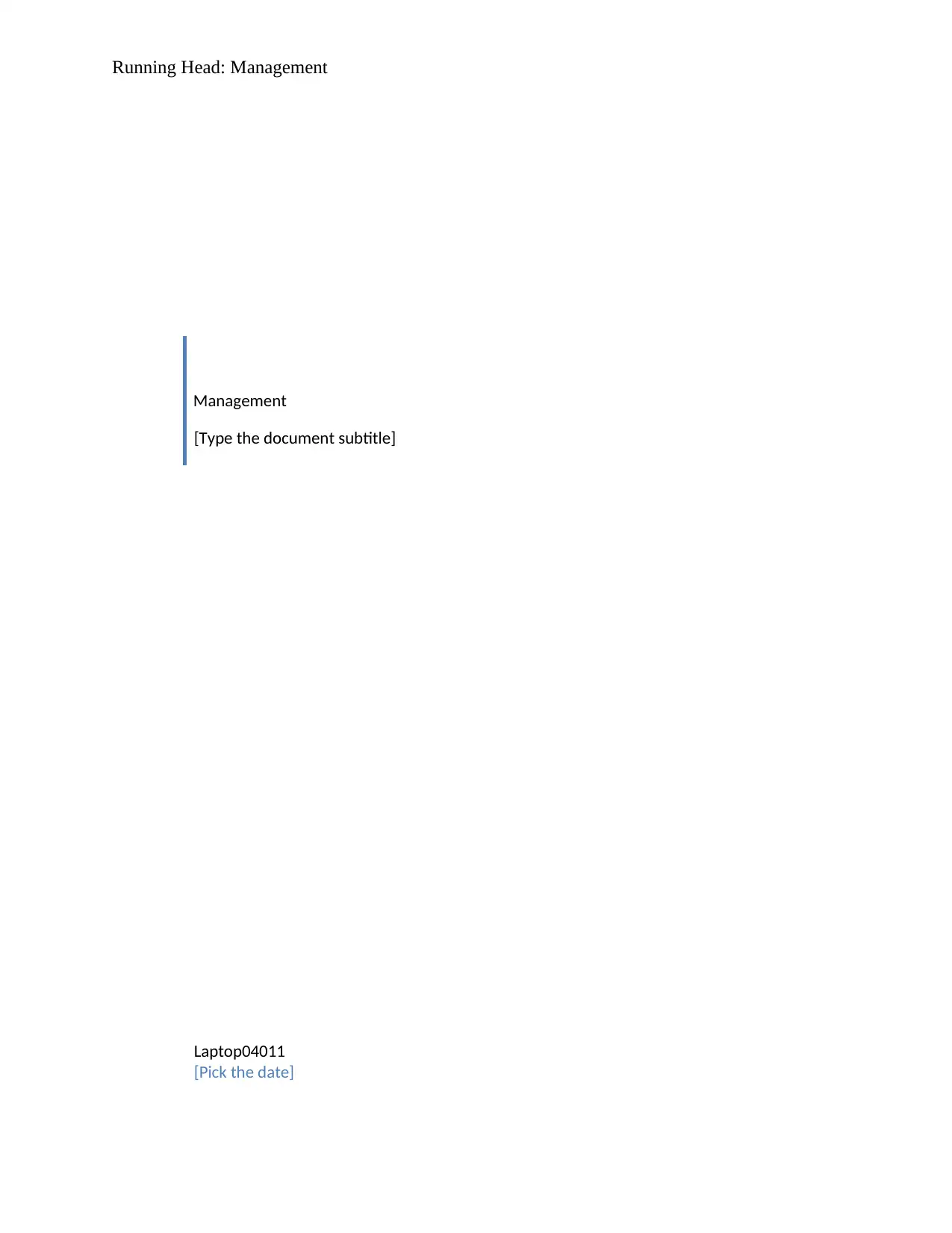
Running Head: Management
Management
[Type the document subtitle]
Laptop04011
[Pick the date]
Management
[Type the document subtitle]
Laptop04011
[Pick the date]
Secure Best Marks with AI Grader
Need help grading? Try our AI Grader for instant feedback on your assignments.
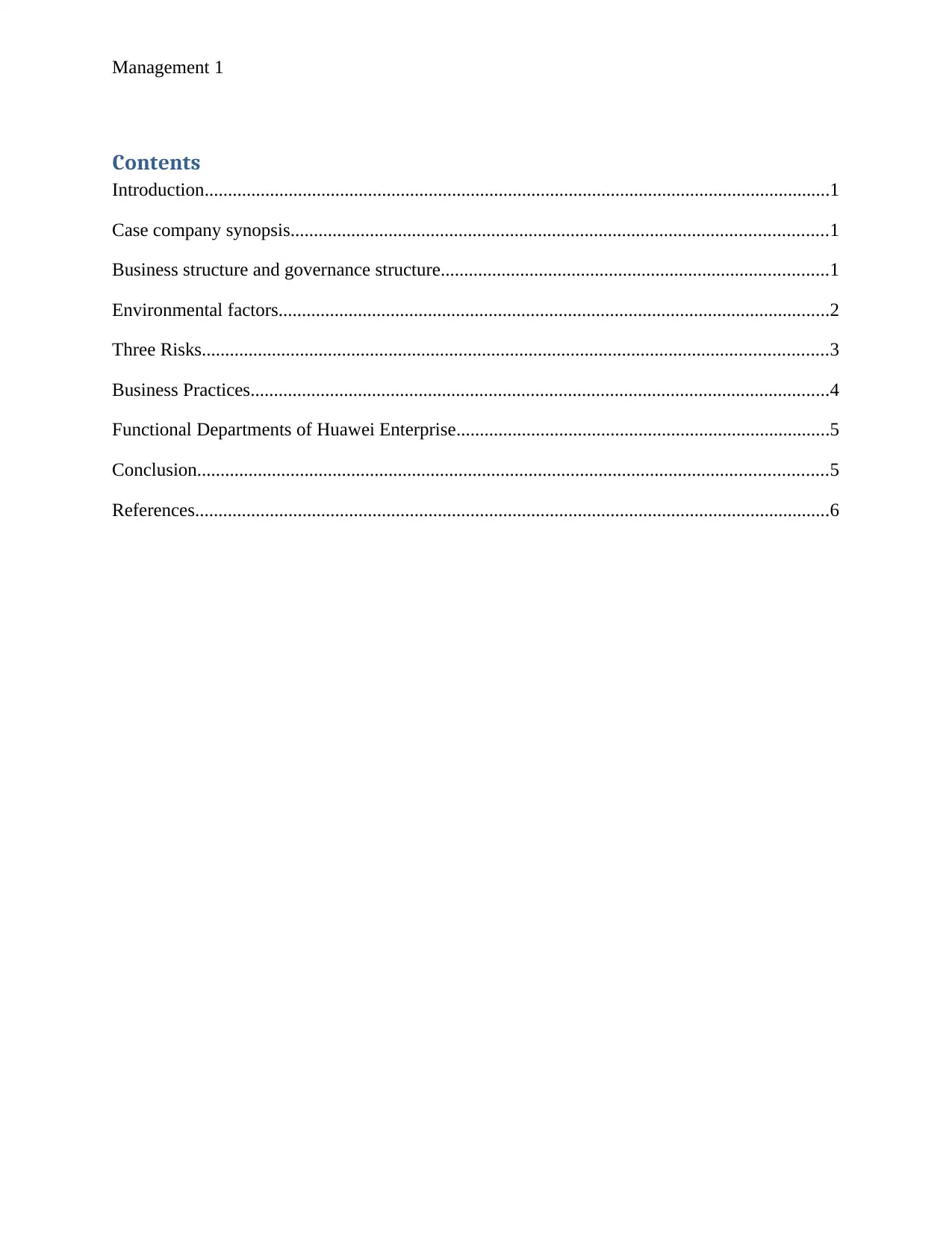
Management 1
Contents
Introduction......................................................................................................................................1
Case company synopsis...................................................................................................................1
Business structure and governance structure...................................................................................1
Environmental factors......................................................................................................................2
Three Risks......................................................................................................................................3
Business Practices............................................................................................................................4
Functional Departments of Huawei Enterprise................................................................................5
Conclusion.......................................................................................................................................5
References........................................................................................................................................6
Contents
Introduction......................................................................................................................................1
Case company synopsis...................................................................................................................1
Business structure and governance structure...................................................................................1
Environmental factors......................................................................................................................2
Three Risks......................................................................................................................................3
Business Practices............................................................................................................................4
Functional Departments of Huawei Enterprise................................................................................5
Conclusion.......................................................................................................................................5
References........................................................................................................................................6
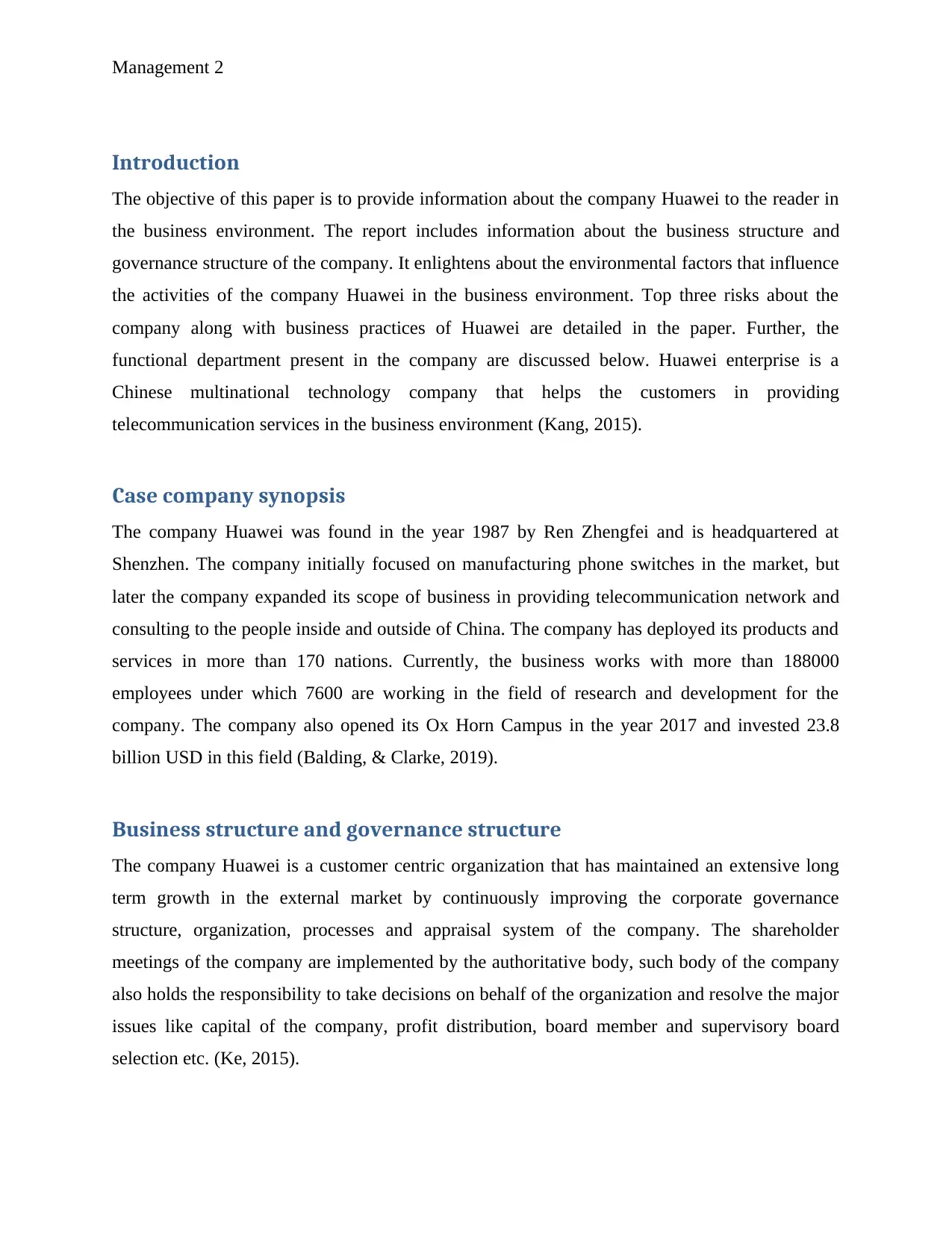
Management 2
Introduction
The objective of this paper is to provide information about the company Huawei to the reader in
the business environment. The report includes information about the business structure and
governance structure of the company. It enlightens about the environmental factors that influence
the activities of the company Huawei in the business environment. Top three risks about the
company along with business practices of Huawei are detailed in the paper. Further, the
functional department present in the company are discussed below. Huawei enterprise is a
Chinese multinational technology company that helps the customers in providing
telecommunication services in the business environment (Kang, 2015).
Case company synopsis
The company Huawei was found in the year 1987 by Ren Zhengfei and is headquartered at
Shenzhen. The company initially focused on manufacturing phone switches in the market, but
later the company expanded its scope of business in providing telecommunication network and
consulting to the people inside and outside of China. The company has deployed its products and
services in more than 170 nations. Currently, the business works with more than 188000
employees under which 7600 are working in the field of research and development for the
company. The company also opened its Ox Horn Campus in the year 2017 and invested 23.8
billion USD in this field (Balding, & Clarke, 2019).
Business structure and governance structure
The company Huawei is a customer centric organization that has maintained an extensive long
term growth in the external market by continuously improving the corporate governance
structure, organization, processes and appraisal system of the company. The shareholder
meetings of the company are implemented by the authoritative body, such body of the company
also holds the responsibility to take decisions on behalf of the organization and resolve the major
issues like capital of the company, profit distribution, board member and supervisory board
selection etc. (Ke, 2015).
Introduction
The objective of this paper is to provide information about the company Huawei to the reader in
the business environment. The report includes information about the business structure and
governance structure of the company. It enlightens about the environmental factors that influence
the activities of the company Huawei in the business environment. Top three risks about the
company along with business practices of Huawei are detailed in the paper. Further, the
functional department present in the company are discussed below. Huawei enterprise is a
Chinese multinational technology company that helps the customers in providing
telecommunication services in the business environment (Kang, 2015).
Case company synopsis
The company Huawei was found in the year 1987 by Ren Zhengfei and is headquartered at
Shenzhen. The company initially focused on manufacturing phone switches in the market, but
later the company expanded its scope of business in providing telecommunication network and
consulting to the people inside and outside of China. The company has deployed its products and
services in more than 170 nations. Currently, the business works with more than 188000
employees under which 7600 are working in the field of research and development for the
company. The company also opened its Ox Horn Campus in the year 2017 and invested 23.8
billion USD in this field (Balding, & Clarke, 2019).
Business structure and governance structure
The company Huawei is a customer centric organization that has maintained an extensive long
term growth in the external market by continuously improving the corporate governance
structure, organization, processes and appraisal system of the company. The shareholder
meetings of the company are implemented by the authoritative body, such body of the company
also holds the responsibility to take decisions on behalf of the organization and resolve the major
issues like capital of the company, profit distribution, board member and supervisory board
selection etc. (Ke, 2015).
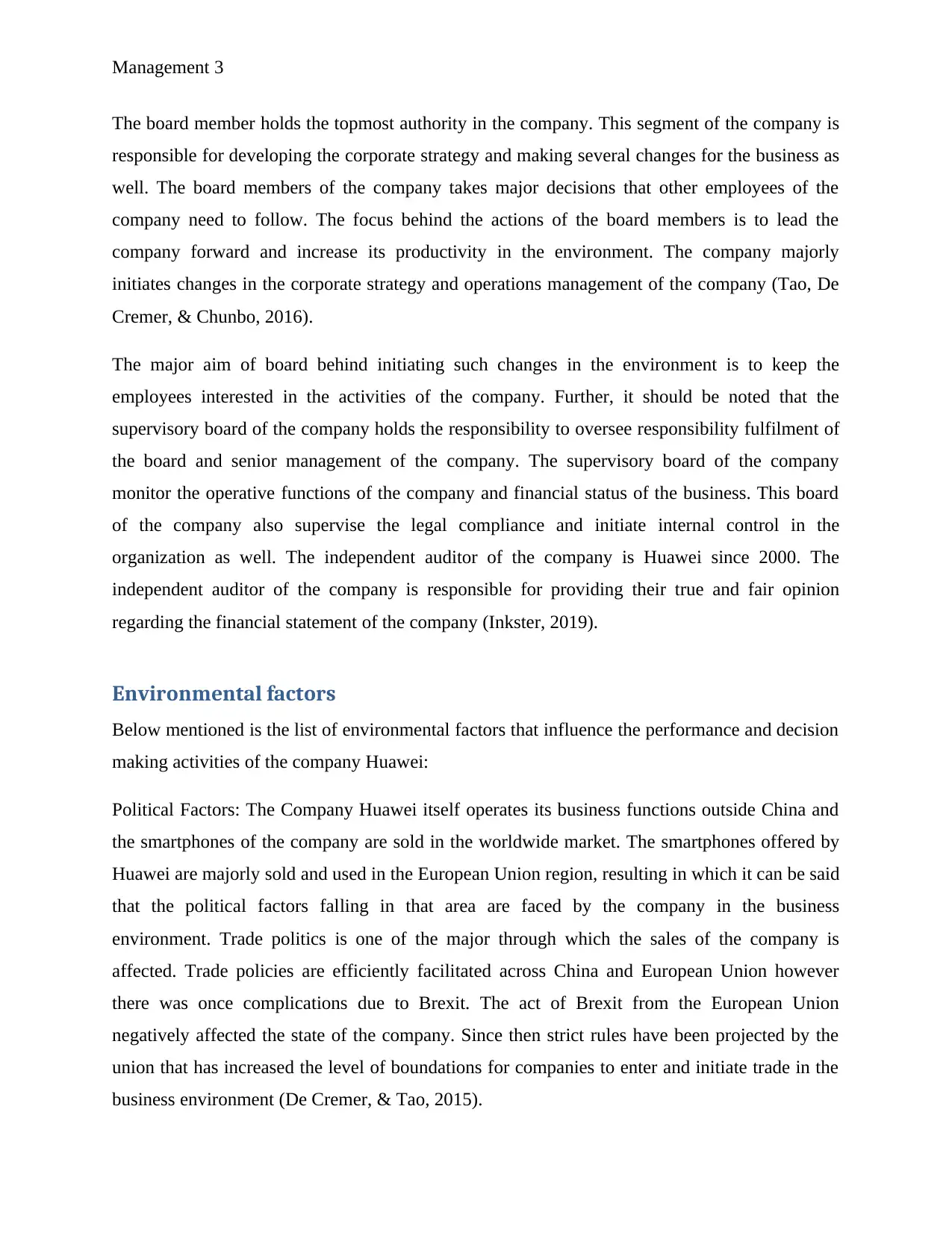
Management 3
The board member holds the topmost authority in the company. This segment of the company is
responsible for developing the corporate strategy and making several changes for the business as
well. The board members of the company takes major decisions that other employees of the
company need to follow. The focus behind the actions of the board members is to lead the
company forward and increase its productivity in the environment. The company majorly
initiates changes in the corporate strategy and operations management of the company (Tao, De
Cremer, & Chunbo, 2016).
The major aim of board behind initiating such changes in the environment is to keep the
employees interested in the activities of the company. Further, it should be noted that the
supervisory board of the company holds the responsibility to oversee responsibility fulfilment of
the board and senior management of the company. The supervisory board of the company
monitor the operative functions of the company and financial status of the business. This board
of the company also supervise the legal compliance and initiate internal control in the
organization as well. The independent auditor of the company is Huawei since 2000. The
independent auditor of the company is responsible for providing their true and fair opinion
regarding the financial statement of the company (Inkster, 2019).
Environmental factors
Below mentioned is the list of environmental factors that influence the performance and decision
making activities of the company Huawei:
Political Factors: The Company Huawei itself operates its business functions outside China and
the smartphones of the company are sold in the worldwide market. The smartphones offered by
Huawei are majorly sold and used in the European Union region, resulting in which it can be said
that the political factors falling in that area are faced by the company in the business
environment. Trade politics is one of the major through which the sales of the company is
affected. Trade policies are efficiently facilitated across China and European Union however
there was once complications due to Brexit. The act of Brexit from the European Union
negatively affected the state of the company. Since then strict rules have been projected by the
union that has increased the level of boundations for companies to enter and initiate trade in the
business environment (De Cremer, & Tao, 2015).
The board member holds the topmost authority in the company. This segment of the company is
responsible for developing the corporate strategy and making several changes for the business as
well. The board members of the company takes major decisions that other employees of the
company need to follow. The focus behind the actions of the board members is to lead the
company forward and increase its productivity in the environment. The company majorly
initiates changes in the corporate strategy and operations management of the company (Tao, De
Cremer, & Chunbo, 2016).
The major aim of board behind initiating such changes in the environment is to keep the
employees interested in the activities of the company. Further, it should be noted that the
supervisory board of the company holds the responsibility to oversee responsibility fulfilment of
the board and senior management of the company. The supervisory board of the company
monitor the operative functions of the company and financial status of the business. This board
of the company also supervise the legal compliance and initiate internal control in the
organization as well. The independent auditor of the company is Huawei since 2000. The
independent auditor of the company is responsible for providing their true and fair opinion
regarding the financial statement of the company (Inkster, 2019).
Environmental factors
Below mentioned is the list of environmental factors that influence the performance and decision
making activities of the company Huawei:
Political Factors: The Company Huawei itself operates its business functions outside China and
the smartphones of the company are sold in the worldwide market. The smartphones offered by
Huawei are majorly sold and used in the European Union region, resulting in which it can be said
that the political factors falling in that area are faced by the company in the business
environment. Trade politics is one of the major through which the sales of the company is
affected. Trade policies are efficiently facilitated across China and European Union however
there was once complications due to Brexit. The act of Brexit from the European Union
negatively affected the state of the company. Since then strict rules have been projected by the
union that has increased the level of boundations for companies to enter and initiate trade in the
business environment (De Cremer, & Tao, 2015).
Secure Best Marks with AI Grader
Need help grading? Try our AI Grader for instant feedback on your assignments.
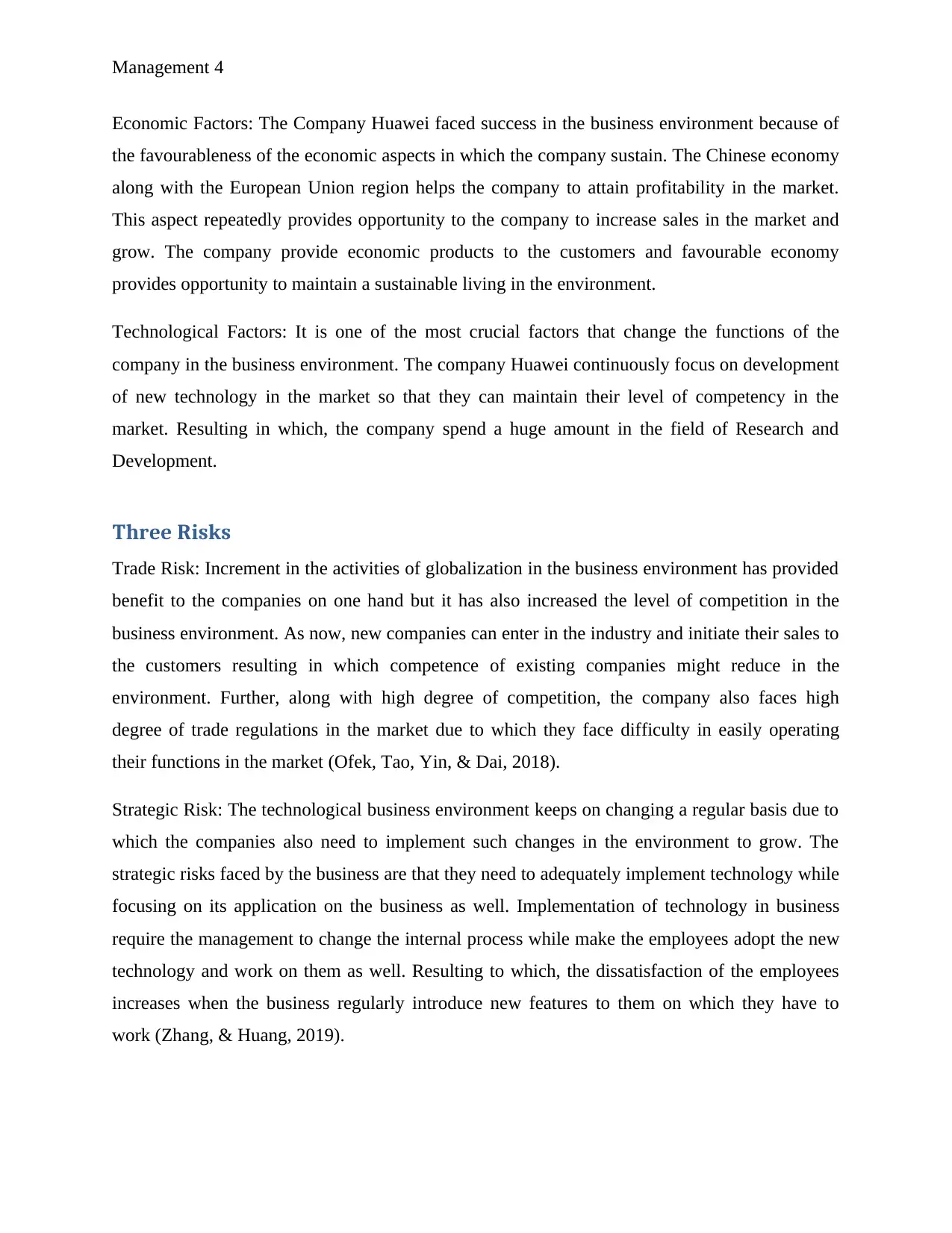
Management 4
Economic Factors: The Company Huawei faced success in the business environment because of
the favourableness of the economic aspects in which the company sustain. The Chinese economy
along with the European Union region helps the company to attain profitability in the market.
This aspect repeatedly provides opportunity to the company to increase sales in the market and
grow. The company provide economic products to the customers and favourable economy
provides opportunity to maintain a sustainable living in the environment.
Technological Factors: It is one of the most crucial factors that change the functions of the
company in the business environment. The company Huawei continuously focus on development
of new technology in the market so that they can maintain their level of competency in the
market. Resulting in which, the company spend a huge amount in the field of Research and
Development.
Three Risks
Trade Risk: Increment in the activities of globalization in the business environment has provided
benefit to the companies on one hand but it has also increased the level of competition in the
business environment. As now, new companies can enter in the industry and initiate their sales to
the customers resulting in which competence of existing companies might reduce in the
environment. Further, along with high degree of competition, the company also faces high
degree of trade regulations in the market due to which they face difficulty in easily operating
their functions in the market (Ofek, Tao, Yin, & Dai, 2018).
Strategic Risk: The technological business environment keeps on changing a regular basis due to
which the companies also need to implement such changes in the environment to grow. The
strategic risks faced by the business are that they need to adequately implement technology while
focusing on its application on the business as well. Implementation of technology in business
require the management to change the internal process while make the employees adopt the new
technology and work on them as well. Resulting to which, the dissatisfaction of the employees
increases when the business regularly introduce new features to them on which they have to
work (Zhang, & Huang, 2019).
Economic Factors: The Company Huawei faced success in the business environment because of
the favourableness of the economic aspects in which the company sustain. The Chinese economy
along with the European Union region helps the company to attain profitability in the market.
This aspect repeatedly provides opportunity to the company to increase sales in the market and
grow. The company provide economic products to the customers and favourable economy
provides opportunity to maintain a sustainable living in the environment.
Technological Factors: It is one of the most crucial factors that change the functions of the
company in the business environment. The company Huawei continuously focus on development
of new technology in the market so that they can maintain their level of competency in the
market. Resulting in which, the company spend a huge amount in the field of Research and
Development.
Three Risks
Trade Risk: Increment in the activities of globalization in the business environment has provided
benefit to the companies on one hand but it has also increased the level of competition in the
business environment. As now, new companies can enter in the industry and initiate their sales to
the customers resulting in which competence of existing companies might reduce in the
environment. Further, along with high degree of competition, the company also faces high
degree of trade regulations in the market due to which they face difficulty in easily operating
their functions in the market (Ofek, Tao, Yin, & Dai, 2018).
Strategic Risk: The technological business environment keeps on changing a regular basis due to
which the companies also need to implement such changes in the environment to grow. The
strategic risks faced by the business are that they need to adequately implement technology while
focusing on its application on the business as well. Implementation of technology in business
require the management to change the internal process while make the employees adopt the new
technology and work on them as well. Resulting to which, the dissatisfaction of the employees
increases when the business regularly introduce new features to them on which they have to
work (Zhang, & Huang, 2019).
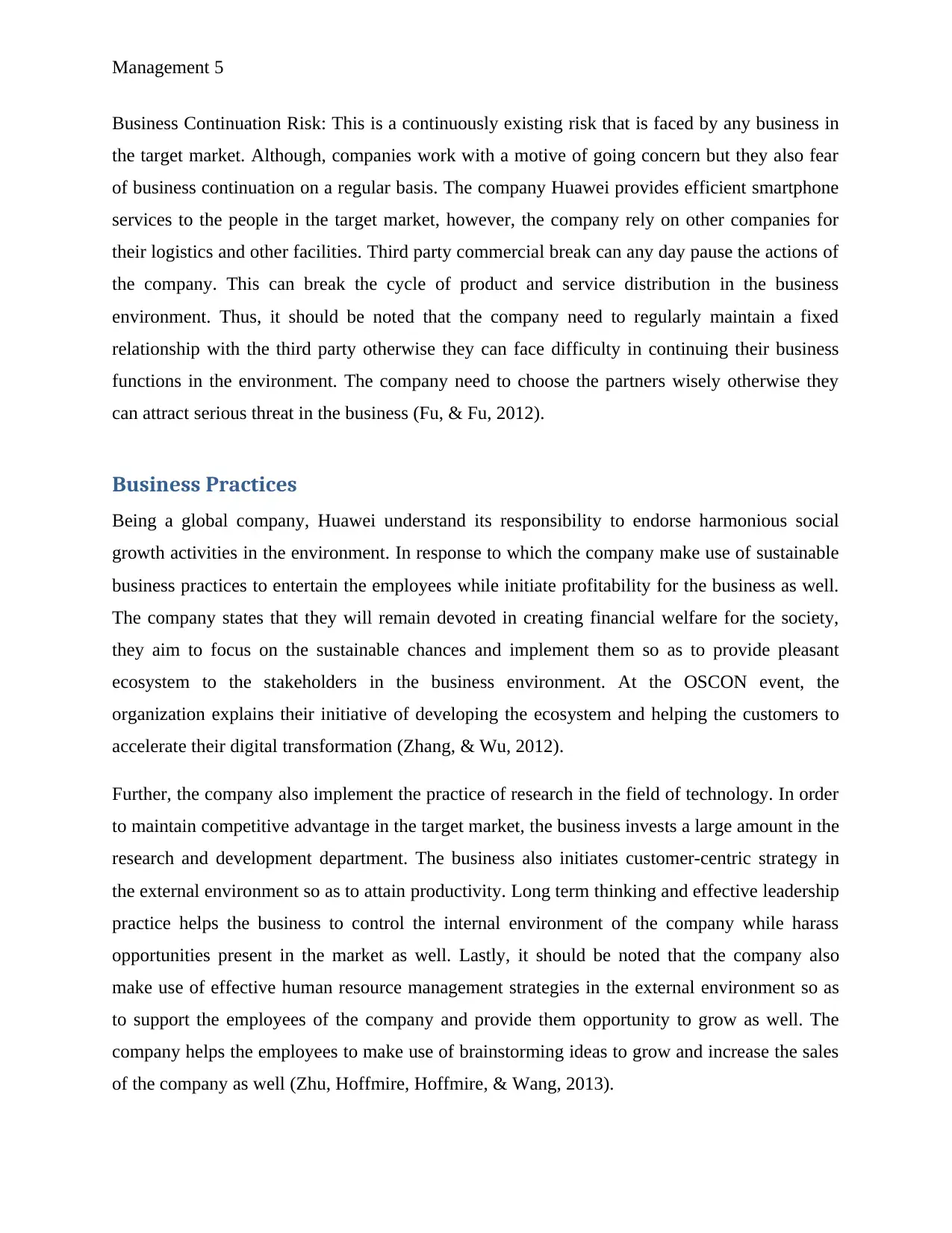
Management 5
Business Continuation Risk: This is a continuously existing risk that is faced by any business in
the target market. Although, companies work with a motive of going concern but they also fear
of business continuation on a regular basis. The company Huawei provides efficient smartphone
services to the people in the target market, however, the company rely on other companies for
their logistics and other facilities. Third party commercial break can any day pause the actions of
the company. This can break the cycle of product and service distribution in the business
environment. Thus, it should be noted that the company need to regularly maintain a fixed
relationship with the third party otherwise they can face difficulty in continuing their business
functions in the environment. The company need to choose the partners wisely otherwise they
can attract serious threat in the business (Fu, & Fu, 2012).
Business Practices
Being a global company, Huawei understand its responsibility to endorse harmonious social
growth activities in the environment. In response to which the company make use of sustainable
business practices to entertain the employees while initiate profitability for the business as well.
The company states that they will remain devoted in creating financial welfare for the society,
they aim to focus on the sustainable chances and implement them so as to provide pleasant
ecosystem to the stakeholders in the business environment. At the OSCON event, the
organization explains their initiative of developing the ecosystem and helping the customers to
accelerate their digital transformation (Zhang, & Wu, 2012).
Further, the company also implement the practice of research in the field of technology. In order
to maintain competitive advantage in the target market, the business invests a large amount in the
research and development department. The business also initiates customer-centric strategy in
the external environment so as to attain productivity. Long term thinking and effective leadership
practice helps the business to control the internal environment of the company while harass
opportunities present in the market as well. Lastly, it should be noted that the company also
make use of effective human resource management strategies in the external environment so as
to support the employees of the company and provide them opportunity to grow as well. The
company helps the employees to make use of brainstorming ideas to grow and increase the sales
of the company as well (Zhu, Hoffmire, Hoffmire, & Wang, 2013).
Business Continuation Risk: This is a continuously existing risk that is faced by any business in
the target market. Although, companies work with a motive of going concern but they also fear
of business continuation on a regular basis. The company Huawei provides efficient smartphone
services to the people in the target market, however, the company rely on other companies for
their logistics and other facilities. Third party commercial break can any day pause the actions of
the company. This can break the cycle of product and service distribution in the business
environment. Thus, it should be noted that the company need to regularly maintain a fixed
relationship with the third party otherwise they can face difficulty in continuing their business
functions in the environment. The company need to choose the partners wisely otherwise they
can attract serious threat in the business (Fu, & Fu, 2012).
Business Practices
Being a global company, Huawei understand its responsibility to endorse harmonious social
growth activities in the environment. In response to which the company make use of sustainable
business practices to entertain the employees while initiate profitability for the business as well.
The company states that they will remain devoted in creating financial welfare for the society,
they aim to focus on the sustainable chances and implement them so as to provide pleasant
ecosystem to the stakeholders in the business environment. At the OSCON event, the
organization explains their initiative of developing the ecosystem and helping the customers to
accelerate their digital transformation (Zhang, & Wu, 2012).
Further, the company also implement the practice of research in the field of technology. In order
to maintain competitive advantage in the target market, the business invests a large amount in the
research and development department. The business also initiates customer-centric strategy in
the external environment so as to attain productivity. Long term thinking and effective leadership
practice helps the business to control the internal environment of the company while harass
opportunities present in the market as well. Lastly, it should be noted that the company also
make use of effective human resource management strategies in the external environment so as
to support the employees of the company and provide them opportunity to grow as well. The
company helps the employees to make use of brainstorming ideas to grow and increase the sales
of the company as well (Zhu, Hoffmire, Hoffmire, & Wang, 2013).
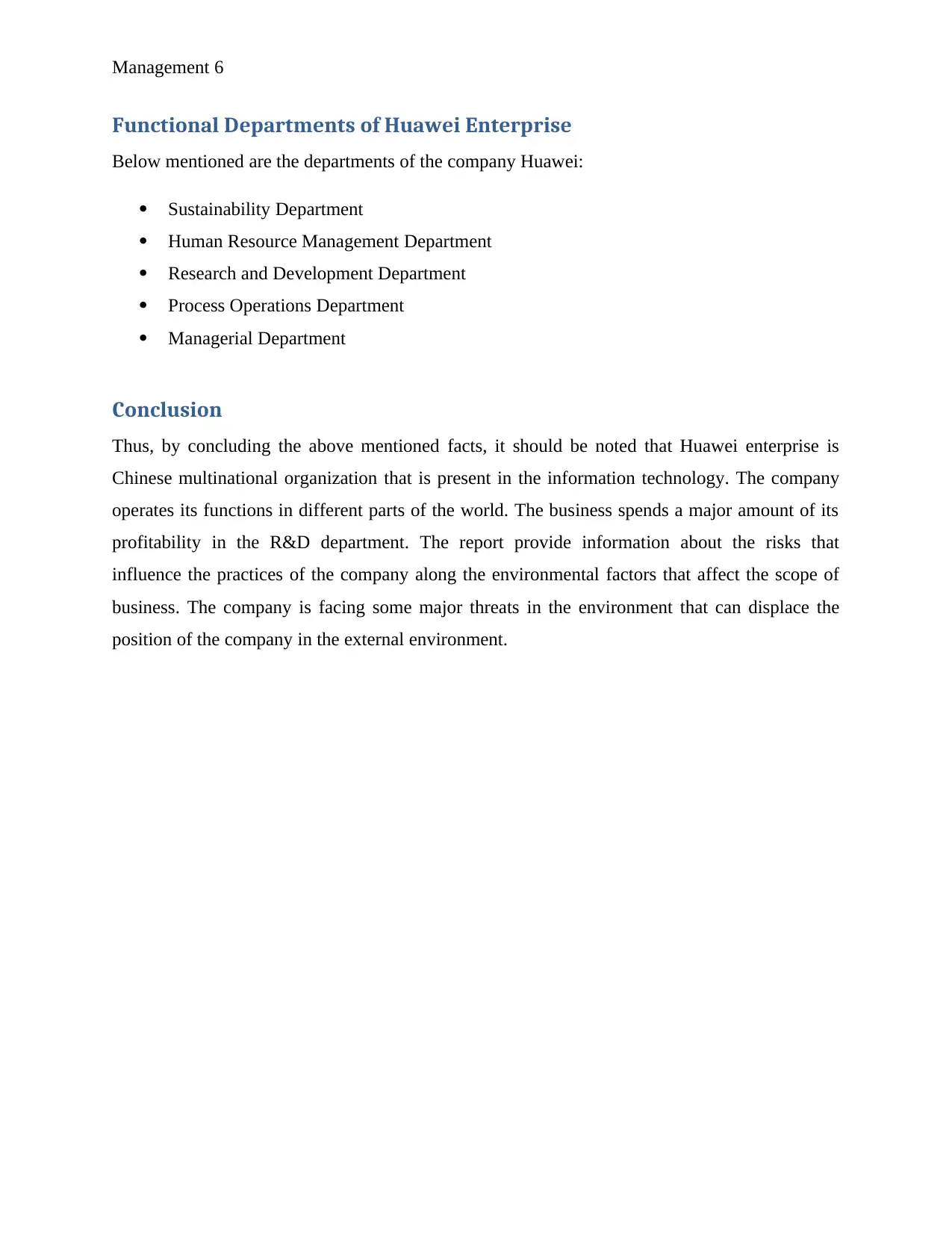
Management 6
Functional Departments of Huawei Enterprise
Below mentioned are the departments of the company Huawei:
Sustainability Department
Human Resource Management Department
Research and Development Department
Process Operations Department
Managerial Department
Conclusion
Thus, by concluding the above mentioned facts, it should be noted that Huawei enterprise is
Chinese multinational organization that is present in the information technology. The company
operates its functions in different parts of the world. The business spends a major amount of its
profitability in the R&D department. The report provide information about the risks that
influence the practices of the company along the environmental factors that affect the scope of
business. The company is facing some major threats in the environment that can displace the
position of the company in the external environment.
Functional Departments of Huawei Enterprise
Below mentioned are the departments of the company Huawei:
Sustainability Department
Human Resource Management Department
Research and Development Department
Process Operations Department
Managerial Department
Conclusion
Thus, by concluding the above mentioned facts, it should be noted that Huawei enterprise is
Chinese multinational organization that is present in the information technology. The company
operates its functions in different parts of the world. The business spends a major amount of its
profitability in the R&D department. The report provide information about the risks that
influence the practices of the company along the environmental factors that affect the scope of
business. The company is facing some major threats in the environment that can displace the
position of the company in the external environment.
Paraphrase This Document
Need a fresh take? Get an instant paraphrase of this document with our AI Paraphraser
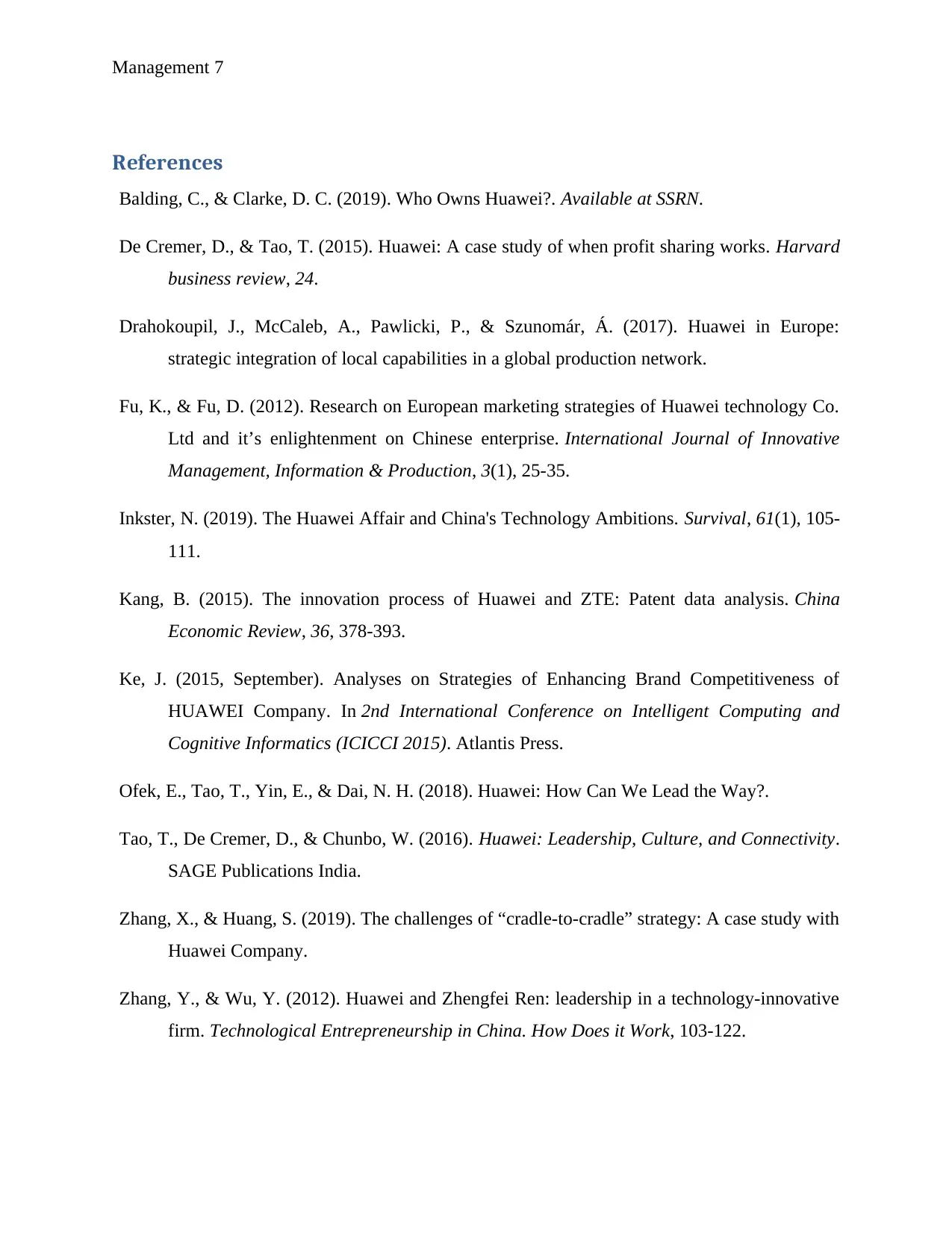
Management 7
References
Balding, C., & Clarke, D. C. (2019). Who Owns Huawei?. Available at SSRN.
De Cremer, D., & Tao, T. (2015). Huawei: A case study of when profit sharing works. Harvard
business review, 24.
Drahokoupil, J., McCaleb, A., Pawlicki, P., & Szunomár, Á. (2017). Huawei in Europe:
strategic integration of local capabilities in a global production network.
Fu, K., & Fu, D. (2012). Research on European marketing strategies of Huawei technology Co.
Ltd and it’s enlightenment on Chinese enterprise. International Journal of Innovative
Management, Information & Production, 3(1), 25-35.
Inkster, N. (2019). The Huawei Affair and China's Technology Ambitions. Survival, 61(1), 105-
111.
Kang, B. (2015). The innovation process of Huawei and ZTE: Patent data analysis. China
Economic Review, 36, 378-393.
Ke, J. (2015, September). Analyses on Strategies of Enhancing Brand Competitiveness of
HUAWEI Company. In 2nd International Conference on Intelligent Computing and
Cognitive Informatics (ICICCI 2015). Atlantis Press.
Ofek, E., Tao, T., Yin, E., & Dai, N. H. (2018). Huawei: How Can We Lead the Way?.
Tao, T., De Cremer, D., & Chunbo, W. (2016). Huawei: Leadership, Culture, and Connectivity.
SAGE Publications India.
Zhang, X., & Huang, S. (2019). The challenges of “cradle-to-cradle” strategy: A case study with
Huawei Company.
Zhang, Y., & Wu, Y. (2012). Huawei and Zhengfei Ren: leadership in a technology-innovative
firm. Technological Entrepreneurship in China. How Does it Work, 103-122.
References
Balding, C., & Clarke, D. C. (2019). Who Owns Huawei?. Available at SSRN.
De Cremer, D., & Tao, T. (2015). Huawei: A case study of when profit sharing works. Harvard
business review, 24.
Drahokoupil, J., McCaleb, A., Pawlicki, P., & Szunomár, Á. (2017). Huawei in Europe:
strategic integration of local capabilities in a global production network.
Fu, K., & Fu, D. (2012). Research on European marketing strategies of Huawei technology Co.
Ltd and it’s enlightenment on Chinese enterprise. International Journal of Innovative
Management, Information & Production, 3(1), 25-35.
Inkster, N. (2019). The Huawei Affair and China's Technology Ambitions. Survival, 61(1), 105-
111.
Kang, B. (2015). The innovation process of Huawei and ZTE: Patent data analysis. China
Economic Review, 36, 378-393.
Ke, J. (2015, September). Analyses on Strategies of Enhancing Brand Competitiveness of
HUAWEI Company. In 2nd International Conference on Intelligent Computing and
Cognitive Informatics (ICICCI 2015). Atlantis Press.
Ofek, E., Tao, T., Yin, E., & Dai, N. H. (2018). Huawei: How Can We Lead the Way?.
Tao, T., De Cremer, D., & Chunbo, W. (2016). Huawei: Leadership, Culture, and Connectivity.
SAGE Publications India.
Zhang, X., & Huang, S. (2019). The challenges of “cradle-to-cradle” strategy: A case study with
Huawei Company.
Zhang, Y., & Wu, Y. (2012). Huawei and Zhengfei Ren: leadership in a technology-innovative
firm. Technological Entrepreneurship in China. How Does it Work, 103-122.
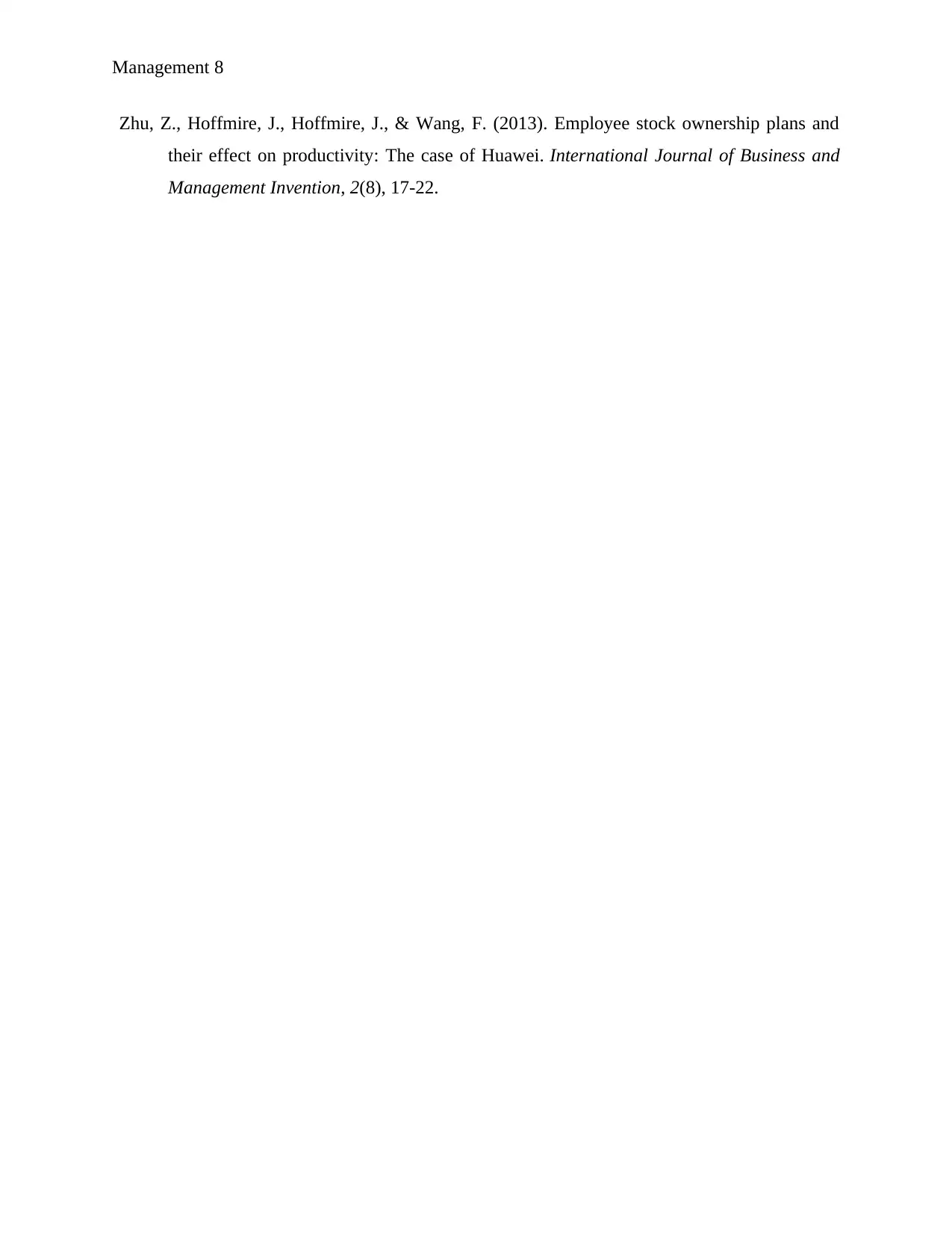
Management 8
Zhu, Z., Hoffmire, J., Hoffmire, J., & Wang, F. (2013). Employee stock ownership plans and
their effect on productivity: The case of Huawei. International Journal of Business and
Management Invention, 2(8), 17-22.
Zhu, Z., Hoffmire, J., Hoffmire, J., & Wang, F. (2013). Employee stock ownership plans and
their effect on productivity: The case of Huawei. International Journal of Business and
Management Invention, 2(8), 17-22.
1 out of 9
Related Documents
Your All-in-One AI-Powered Toolkit for Academic Success.
+13062052269
info@desklib.com
Available 24*7 on WhatsApp / Email
![[object Object]](/_next/static/media/star-bottom.7253800d.svg)
Unlock your academic potential
© 2024 | Zucol Services PVT LTD | All rights reserved.





